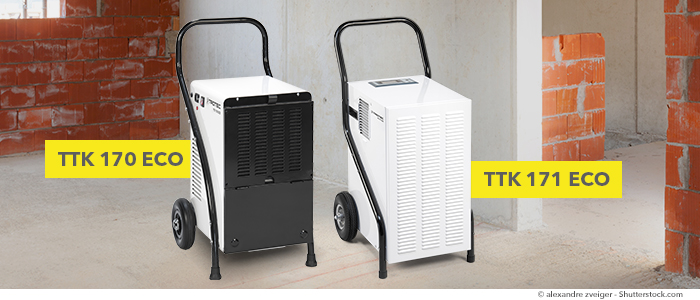From the outside, with their sturdy metal housing and their large wheels, the industrial dehumidifier and construction dryer look the alike. But a quick look under the bonnet and the big difference is clear – it’s the hot gas defrosting system. If you are looking for a construction dryer that also still functions reliably at temperatures under 15 °C, the first thing you should ask about is hot gas defrosting. If it doesn’t have it, it’s not a construction dryer…
Did you know that, in general, on construction sites in central Europe the temperature is less than 15 °C, at least overnight, on over 200 days a year? At these kinds of temperatures the normal dehumidification in conventional industrial dehumidifiers with electronic defrosting stops working – but for real construction dryers with hot gas defrosting, such as Trotec’s TTK 170 ECO and the TTK 171 ECO, these temperatures are not a cause for concern, in fact these driers carrying on working just as highly efficiently as always. But why does this happen?
Industrial dryers are usually condenser dryers
They condense the moisture in the air of the room, collect the condensation and then get rid of it. The moisture is continually extracted and the air becomes drier. However, in order for the extracted air to condense, it must be cooled down so that its temperature drops below the dew point. This takes place in the drying unit’s evaporator, which rapidly cools the air by channelling it through a reduced-pressure coolant. But at an outdoor temperature of 16 °C to 17 °C the evaporator begins to freeze, resulting in a steady reduction of performance that would eventually lead to a complete system failure.
Conventional industrial dehumidifiers only use electronic defrosting
That’s why condenser driers are mostly equipped with an electronic time or sensor-controlled defrosting system set to regularly de-ice the evaporator. Defrosting usually takes place using an electronic time or sensor-controlled air circulating system and is often called electronic defrosting for this reason: The compressor is switched off in defrost mode while the fan usually continues running and the waste heat from the compressor circulates around the evaporator to keep it free of ice. This process generally works fine in heated conditions where the temperature is above approx. 15 °C.
But if these kinds of driers are used in environments where the temperature is below 15 °C the dew point will be significantly lower. This process leads to more ice formation on the evaporator, which then in practice has to be constantly defrosted in air circulating defrost units due to the extended duration of the defrost cycle. So, normal dehumidification no longer occurs, because air dehumidification only takes place in the drying units’ non-defrost phases.
Real construction driers use professional hot gas defrosting
And this is the decisive factor that makes the big difference between the ‘normal’ industrial dehumidifier and the ‘real’ construction drier: Genuine construction driers, such as Trotec’s TTK 170 ECO and the TTK 171 ECO are equipped with a completely different defrosting system – hot gas defrosting using a bypass procedure. The hot gas from the refrigeration cycle is actively used to quickly and effectively defrost. As soon as ice begins to form, a special valve is opened automatically to channel the hot gas around the evaporator. When this has defrosted the gas then rejoins the main refrigeration cycle again for the drying cycle. This is how the hot gas defrosting system manages to have much shorter defrost phases, which is an essential requirement for effective dehumidification – both in environments with low temperatures and in unheated spaces.
TTK 170 ECO and TTK 171 ECO – two genuine professional driers for your construction sites
Thanks to a professional hot gas system the TTK 170 ECO and TTK 171 ECO construction driers manage to achieve high dehumidification performance even at low temperatures, in unheated spaces or on cold construction sites. Why not see for yourself: find out about the advantages as well as our current offers for these professional driers – now in the Trotec shop!


